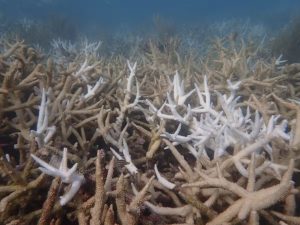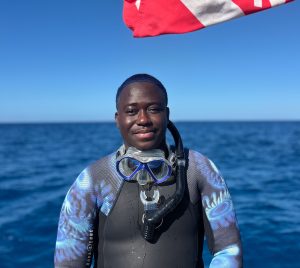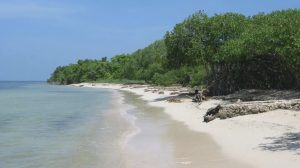Photogrammetry extracts 3-dimensional information from multiple photos of the same thing. In a nutshell, it relies on computer vision processes to find overlapping points between photos, and then can re-create the original 3-dimensional orientation of the cameras and the things you photograph. At the Perry Institute for Marine Science, we’re using photogrammetry as a tool for both reef health monitoring and for education.By taking photos in a grid over sections of a coral reef, we can build extremely high-resolution maps of the benthic surface that can be analyzed in a host of different ways, complementing our underwater data collection and enabling us to keep better track of how reefs are changing over time. The process also can be used to generate 3D models of corals, which are an amazing tool for research, and for education. The 3D models are high enough resolution to be used to demonstrate what reefs actually look like underwater, helping to show people who may never get the chance to scuba dive the magical world of corals. It can also serve as a great tool to teach future marine biologists how to identify different species before they even put on a mask.

First, divers take multiple photos of the same reef section or coral head, following a grid-like pattern. Then, these photos are processed into high-resolution 3D models using Agisoft Metashape software.

This 3D model above, created using photogrammetry, includes critically endangered Elkhorn (Acropora palmata) and Staghorn (Acropora cervicornis) corals. Can you spot these two species?
Practice Identifying Common Caribbean Corals Below
The model below is an example of a reef ball, built by tiny coral organisms laying down their calcium carbonate skeletons on top of one another over thousands of years, at Sandy Cay Reef off Abaco. The model was constructed from just 36 photos,taken while swimming in a circle around the ball, and demonstrates the remarkable diversity of hard corals found within just a couple square meters of reef. There are at least nine different species visible! Click through the annotations in the interactive model to check them all out.Note: This is best viewed in a web browser on a computer, not on a mobile device.

Build a Coral Reef for the Holidays | PIMS x Partanna
PIMS is partnering with Partanna to build a 100m² carbon-negative reef. Rick Fox is matching donations up to $25k. Help us build a sanctuary for the future.

“Seafood Nation” Documentary Premiere Explores the Heart of Bahamian Culture and the Future of Fisheries
NASSAU, The Bahamas | December 5, 2025 – From the bustling stalls of Potter’s Cay to family kitchen tables across the archipelago, seafood is far more than just sustenance in

PIMS and Disney Conservation Fund Partner to Train 19 Government Divers
PIMS dive training in Nassau strengthened national coral restoration capacity across government agencies. Bahamas Dive Training Builds National Coral Restoration Capacity Last fall, between the months of September and October,

Florida’s Coral Reef Crossed a Line: What Functional Extinction Really Means for Elkhorn and Staghorn Corals
Reefs didn’t just bleach. They functionally vanished in one summer. A new Science study co-authored by researchers from the Perry Institute for Marine Science (PIMS) has found that Florida’s two

Q&A: Understanding the IDC Course at PIMS with Duran Mitchell
A former aquarist turned coral conservationist, Duran is passionate about understanding how all marine life connects. PIMS & IDC: Empowering New Dive Instructors for Marine Conservation PIMS & IDC: Empowering

Forbes Shines a Spotlight on Coral Reef Restoration in the Caribbean
When Forbes highlights coral reef restoration, it signals something powerful: the world is paying attention to the urgent fight to protect reefs. And solutions are within reach. Recently, Forbes featured Dr. Valeria


